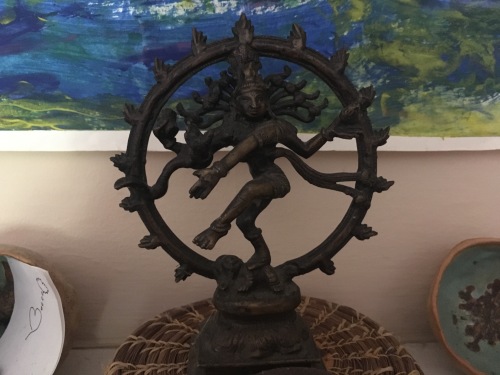Sometimes life gets difficult, out of the blue. I’ve spent this week wrangling shadows I thought had long been laid to rest, struggling with angry and caustic pieces of myself I would love to think had evolved away.

Last night, I put a beautiful statue of Kali on my altar and burned sage and cried on the hands (and arms and shoulders) of my beloved and did angry, sweaty, yoga, throwing everything I know how to throw at these heavy and painful feelings. They are still there: rage at situations in which I feel powerless over the wellbeing of my children; deep sorrow at the ugly shadows of my country that keep emerging; self-hatred over old behaviors and habits that hurt the ones I love. I pull them out of myself like an endless ball of dark thread, spilling it all into the laps of trusted friends and family, allowing it come into the light like a bloodletting.
It still hurts, knowing that this murderous rage lives in me. But when I speak it, when I acknowledge it and move it through me, it loses the power to secretly poison my internal world. It is tempting to hide this side of myself, but I know it is far braver to witness it for what it is, to face its consequences openly.
In a few weeks I am holding a workshop with my friend Maeve on the intersection of permaculture and wellness psychology, and the first week’s theme is Everything Gardens.
We teach what we need to learn.
Everything gardens. Deer nibble complete circles around the bark of trees, killing them so that they fall and provide habitat for grubs and other insects for winter food. Beaver build homes that function as dams, increasing the habitat of their favored foods and placing it right at their backdoor. Anger, held within, gardens a healthy space for itself to continue to grow and increase. If we are not actively gardening our thoughts and environments, they are gardening us.

It could be as simple as a grouchy co-worker that you would do anything to avoid. That co-worker gardens your daily path around the office. Or a sudden rainstorm that cancels the hike you’d planned. The weather gardens the shape of your day.
The first step in any permaculture design is a careful observation of the land, where the sun rises and sets in each season, how rain moves across the landscape, if there is a neighbor’s dog that always pees in a certain spot, or a wind that blows strongly from the north every winter. These forces, once observed, can be interacted with: either channeled into the design or counterbalanced. For example, carefully dug swales along the contour of the land can capture rainwater that would otherwise have sluiced and eroded across the landscape, allowing it to filter deep into the ground and nourish the roots of plants long after the surface soil has gone dry. Wind can power a well-placed windmill, generating electricity or pumping water for driplines. Dogs can be trained to pee on compost piles, depositing nitrogen where it is needed rather than burning the delicate leaves of a new plant.
In the same way, we can train ourselves to observe the forces that move across our own landscapes.
It can be external: I observe for a while that I am grouchy when it rains and I can’t spend my lunch hour outside, so I purchase an umbrella that lives in my office. It can be internal: I notice that there is a certain time each month that I feel angry and raw, so I learn to take that time off to myself and away from any relationships that I might hurt with processing that should have been internal. It all starts with observation and the willingness to be aware of my own habits, the invisible forces that influence me.
Everything Gardens means that I am being shaped constantly whether I participate in it or not. As the saying goes, if I keep walking down a road, chances are I am going to get where I’m going!

I am learning to bravely look at what gardens me so that I can choose my road. It is neither simple nor easy, but it is incredibly valuable. And I have discovered a strange beauty that emerges when I have allowed the anger and the hurt and the ugliness to safely express themselves, and find I am still standing at the end.

Pingback: Permaculture and the Psyche Part 2: Stacking Functions | truebeautyalways